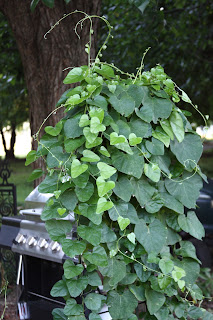Hydrangea Happiness from Proven Winners

Proven Winners is introducing their new Invincibelle Spirit II Smooth Hydrangea arborescens and I would love to have that hedge in the photo, wouldn't you? PW calls this one an overachiever because it blooms and re-blooms - just what we need our Hydrangeas to do! I confess to a deep love affair with Annabelle the original Hydrangea discovered in 1910 in Anna Illinois. Her huge white snowball blossom clusters are durable for drying and the plant itself is trouble tree. Invincibelle Spirit is a hybrid of native Annabelle, durable and reliable but with pink flowers. It's cold hardy to zone 3 and happy up to zone 9. It is said to enjoy full sun but I think in our zone 7 heat, a bit of afternoon shade would no doubt work well, too. The pink flowers start out dark buds that open to hot pink clusters, fading to soft pink as the flowers age. Then, wonder of beauties, they become green. No deadheading, heat tolerant, care-free, Invincible S...











